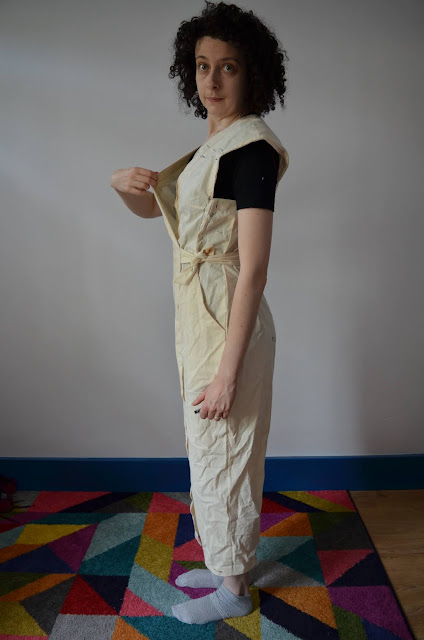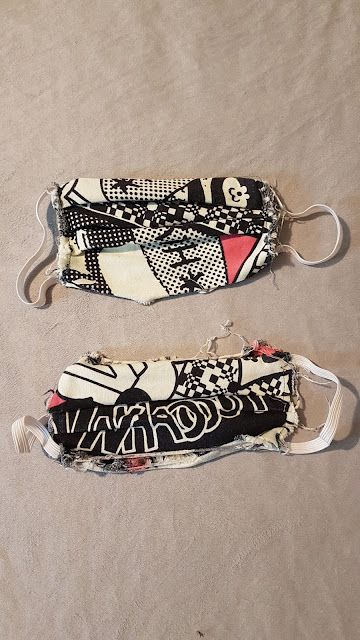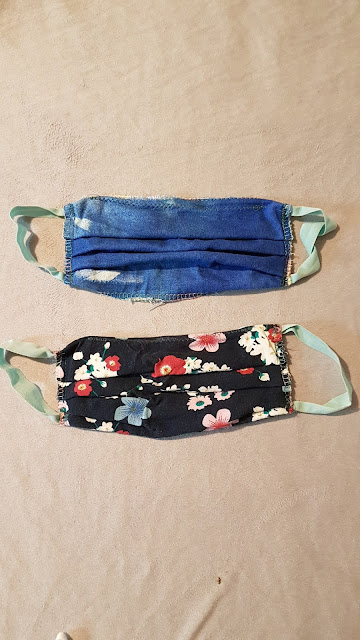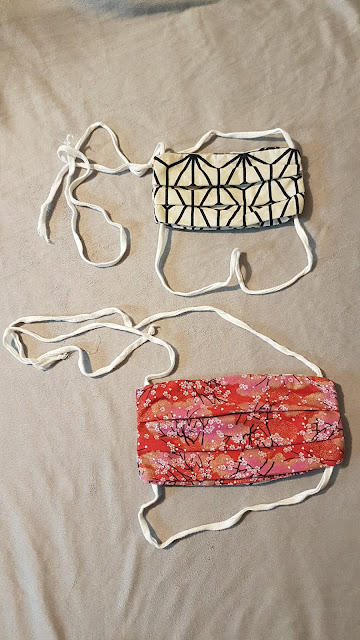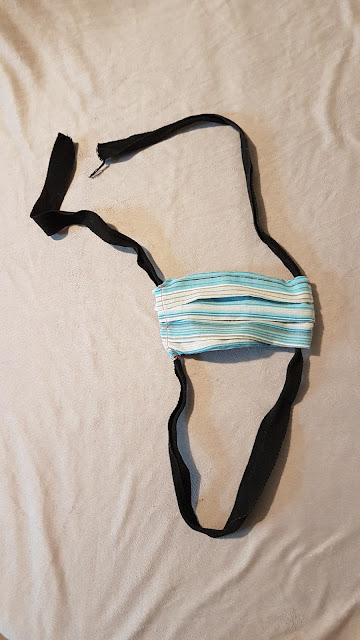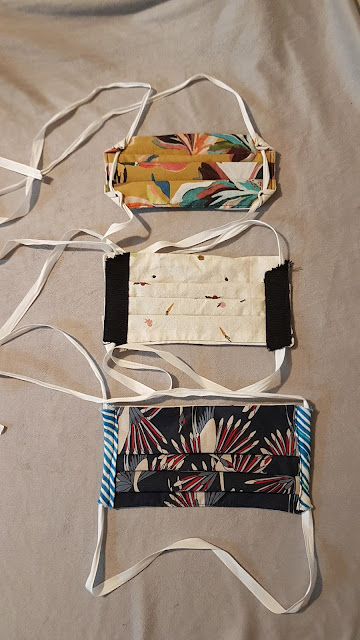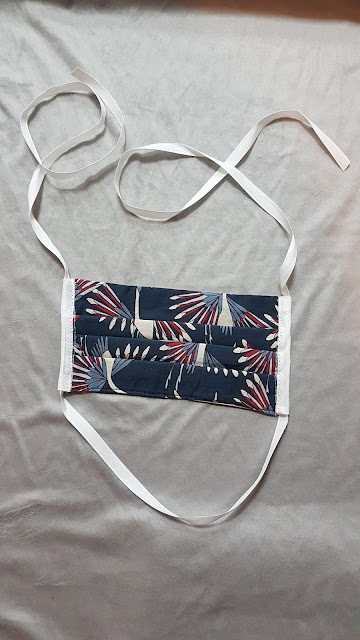I wasn't expecting to fall in love with a second jumpsuit, but when V1645 was announced it caught my attention immediately. I do love a bit of asymmetry and this looked like a really cool asymmetric style. It is another striking jumpsuit from Vogue with very interesting detailing, unlined and with a Hong Kong/bias finish throughout.
I've made 2 muslins and 2 versions now so I feel like I know the pattern pretty well. This post is going to be relatively long and I am expecting it to cover the story of making the jumpsuits, but also cover some of the issues I encountered while doing so. I'll try to break it up under a few different headings.
V1645 elsewhere on the web
I waited before making the jumpsuit to see some reviews pop up. Most of them have been really positive about the design and the look, although there seems to also be some general disappointment the first time the jumpsuit is tried on. I did go through this too but it didn't actually lead to any changes or adjustments in the garment. I think this is an odd look to get used to wearing, but it does look stunning and comes out almost exactly like the original photos.
A few reviews also complained about the instructions being confusing. I have to agree with this, but it does get you a good final result. The pattern has about 60 individual steps (excluding all the binding!) and there are so many notches and tacks to keep track of. Don't skip ANY of these. I didn't find any to be in the wrong place, but it was easy to confuse notches for different sizes and mark the wrong one.
The pocket insertion is confusing, but no moreso than the pockets for the Burda Matt Williamson dress (or dresses of that style, like TATB Zadie dress). You definitely need to be intermediate/advanced skill for this pattern - if there are omissions with the instructions, as highlighted by a couple of other people on PatternReview, I think you can skim over them if you've got enough experience to have your own opinions about how clothes seams should be made/finished. If the front overlay is supposed to be topstitched (as it appears in the envelope photo) then the instruction is definitely missing.
The pattern is cut partially on a single layer, and partially on a double layer. The asymmetrical pieces mean there's a really high risk of cutting a large piece the wrong side out or stitching one of the first seams the wrong way around. This could be a costly mistake if you've got a nice fabric.
I didn't find much elsewhere on the internet about my issues with the supplies list...
As a non-American I found the supplies list incredibly unhelpful when it called for 7x packs of bias tape. In the UK you most often see bias binding available by the cut metre so the requirement for 7x packs was unhelpful. We can't be the only location where bias tape is mainly sold by the metre instead of pre-cut packs. I googled the length of a pack of bias tape at Joanns, which said it was 4 yards so 7x4 yards = 28 yards => 25.6m. I guess. Apparently you can buy packs of bias binding at Hobby Craft, but this is 2.5m so you'd need 10 packs of that stuff at least. I'm fairly sure other brands would have pre-cut packs of different length. I bought a 33m spool of green binding from William Gee and and then a 25m cream spool (from Backstitch) for my second version. Both had significant leftovers at the end of the project. Depending how you choose to finish the seams, you probably need somewhere between 20 and 25m of bias binding.
Also, perhaps buckle covering kits are a easy to find in the USA, but finding nice buckles or buckle covering kits was impossible here so I opted for an adjustable slider at the waistband on both versions.
Muslins and Fitting
My measurements have increased a bit recently so I cut a straight Medium for my first muslin, mainly to account for my hip size. I was unsure how all the pattern pieces were supposed to go together and so I wanted to avoid introducing potential problems of grading between sizes incorrectly. I numbered all of the pattern pieces with a sharpie so I could reference how they go together. Naturally the first muslin ended up too big. I resolved to go down too a Small all over with a small amount of extra space at the hips instead.
I will flag some of the classic errors in my first muslin you need to look out for. Honestly, if you can lay the first few pieces flat or drape them on a dressform, this will really help to establish how the first pieces go together and what shapes they make. On my first muslin, the Centre Front seam ended up the wrong way out. In the subsequent muslins and garment makes, I tried to vary the order of construction to start with the back pieces (which are symmetrical) and then add the front ones to it to get the left front and right front pieces correctly oriented, but it messed up the sensible order of seam finishing as a result.
On the first muslin my right leg outseam [under the overlay] was also incorrect. You should hide outseams inside the legs like normal trousers, but it's relatively easy to get this wrong because there is an invisible zip insertion at the same time.
On the first muslin, I also noticed that the body was too long. The hem, crotch, belt and armholes were all too low on my body. Perhaps this pattern expected a lot more boob to fill out the long upper body (Mimi G and Erika Bunker don't seem to have the low armhole problems that other makers had). For reference, I took some photos to demonstrate how much extra space there was in the bodice that could be filled out.
I did a bit of a slapdash Small Bust Adjustment to match my figure a little better by pinning length out of the bodice above the bust and across the upper back. I didn't specifically adjust the circumference of the pattern pieces but I was hoping that downsizing to an S would just fix it enough to carry on. Muslin 2:
Muslin 2 looked good enough so I made no further changes. There is a small amount of gapping under the arms but I was unwilling to spend time to fix it.
The Creepy Crepe Version
Version 1 is made in a green polyester crepe from Stoff & Still. I have a love/hate relationship with crepe and am always wary of sewing/wearing it but it seemed like a very strong match for this pattern. Crepe has some visual texture that looks rich in photos, polyester crepe is easycare/non-wrinkling and I feel like this is a recognisable use of the fabric (RTW crepe jumpsuits are smart and relatively forgiving of minor fit issues!). So I decided to look past my mistrust and give this a try.
FYI I used the red colourway of this fabric for my V1672 Festive Dress.
To stabilise the fabric I used cotton tape on the shoulder seams, fusible interfacing on all the advised edges and in a few extra places around the pockets. With hindsight I should've also stabilised the zip area.
I accidentally ordered the wrong seam binding (green from William Gee) and it was super narrow. Some of my binding is a bit messy in places where it was tricky to attach, or where I realised too late I had finished seams in the wrong order. I am hoping no one will notice.
I found the crepe a little challenging to work with. It has a tendency to creep, stretch and drape which needs to be kept under control. It's a bit springy when trimming the seam allowances and it doesn't press at all. Machine topstitching is an absolute no-no so I stitched down the facing and hems by hand with a tiny herringbone stitch. The crepe was very forgiving of this kind of stitching.
I messed up the pocket construction on the zip side and some stuff is caught, causing a lumpy seam. I can see it, but it seems to not show up in photos so I am trying not to fuss over it too much.
Once completed the jumpsuit is quite heavy and there's a lot of fabric hanging off the shoulders without much of an anchor elsewhere. Like I said earlier, the crepe stretches and drapes gradually, so the front and overlay were slowly pulling down and apart from one another. You wouldn't get this in a more stable fabric (it didn't happen in the muslin!) so I fixed it by attaching a small hook and eye at the top of the Centre Front seam. It's much better now.
Stick around to hear about the occasion this was made for in a future blog post!
Slinky Smooth Tencel Twill
This was supposed to be a wearable muslin, but I found this fabric AFTER I had completed the green version. You're probably wondering why I was still hunting for wearable muslin fabric when I had completed the main non-test garment. I'm wondering too.
This is a maroon smooth drape twill with tencel fibres by MeetMilk from Sew Me Sunshine. Hopefully this will be a more casual everyday version (complete with wrinkles) and I'm planning to make some long sleeve tees to go under it. The fabric is fun to sew and presses nicely. I wish the colour were a bit more red but it's fine. I noticed while pressing this fabric that it tends to ignore a bit of water (i.e. a fine spray or mist) but it really drinks once wet. Once wet it sort of smells and behaves like a ratty cotton that is beginning to perish slightly in the laundry. I wonder how it'll fare out in the wild!
My binding went a lot better on this version but it's still not perfect. The cream binding was a much better width and the fabric was easier to sandwich in one pass. I also learned some lessons from the previous attempt at binding and machine topstitching was allowed again!
I shortened the belt a little and tried to put it a little higher than on the green version (where I bluffed the placement because I forgot to mark it with a tailor tack).
Trying it on, I was pleased with the fit through the torso. I was a little disappointed with multiple issues below the hipline. Firstly, the pockets are lumpy and I'm not sure why they don't lie smoothly (the muslins were alright!). Secondly, the leg seam with the overlay ripples and pulls down. Maybe I should've cut the whole thing as a double layer and interfaced it like cardboard. It's disappointing. This version also fits quite snug over my hips - I sized down a little after the green version but it may have been too much!
Conclusion
So what are my concluding thoughts on this pattern? I think this would be a relatively good office outfit, but not really in a work from home setting. The inconvenience of using the loo seems pretty egregious when you're stuck in your own home.
The crisper and sturdier your fabric, the better. I think the muslins showed a lot of potential to support the design elements, but the garment fabrics are maybe a bit too drapey. The bust is much bigger than expected, but the enveloped model doesn't seem too well-endowed so I I'm not sure how or why it fits her. She might be very long-bodied. The pockets are okay but a bit tricky to execute if you're grading between sizes in the waist/hip area, especially given the zip and overlay interference. The binding finish is fine but you could equally overlock all the edges before stitching. If you really like a challenge, I bet this whole thing could be made with French Seams. The pattern is a slog to complete because the first 28 steps seem to come together very quickly compared to the second half of the instructions. It is a fun puzzle if you're familiar with garment construction already and you don't mind being thrown by pattern pieces that don't look familiar.
K x








